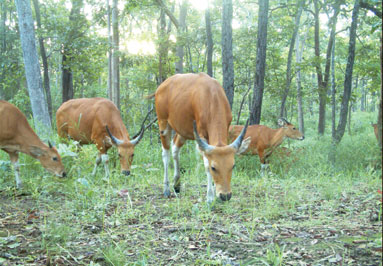Derek Stout
The Phnom Penh Post
Surveys conducted by the World Wildlife Foundation have revealed that the world’s largest population of banteng, an endangered species of cattle that once thrived in the Kingdom, remains at risk due to economic land concessions and poaching inside protected areas.
An estimated 2,700 to 5,700 banteng live on the eastern plains of Cambodia, primarily in the Mondulkiri province’s Protected Forest and the Phnom Prich Wildlife Sanctuary. The total global population is estimated to be between 5,900 to 11,000.
The number of banteng in Cambodia has decreased by more than 50 percent in the last 30 years causing them to be officially listed by International Union for Conservation of Nature as globally endangered in 1996, said the statement released yesterday by the WWF.
The surveys, conducted between 2009 and 2011, were directed towards researching the levels of species preyed on by tigers as part of conservation groups and the government’s strategy to restore the eastern plains as the primary tiger landscape in the Kingdom.
“For the tiger population to recover, one of the most important things needed is a sustainable source of prey, such as banteng,” the statement said.
Poaching the banteng for its meat and horns was once the primary threat, however the WWF report shows that: “the Eastern Plains landscape is severely threatened by social and agricultural land concessions and infrastructure projects.”
“For tigers and prey species- including a globally endangered banteng population to recover within the landscape, stronger protected area management and a commitment to conservation from high levels of Cambodian government are essential,” WWF species conservation manager Nick Cox said.
“Anything less threatens to unravel a decade of conservation progress and with each passing day diminishes the Eastern Plains’ value as a national and global ecological asset for current and future generations.”
The research also confirmed that several other large mammals that are prey animals for tigers, such as wild pigs and muntjac deer, have suffered substantial declines in population across the Kingdom and the rest of Southeast Asia in the past few decades.


























6 comments:
thank god, cambodia still contain some of the world rarest animal species, unlike some other countries around the globe! i hope we all help to protect certain areas of cambodia to be home of these rare animals as they have no other place to called home. don't be like neighboring countries where these animals once roamed freely are gone forever; however, in cambodia, they are still existed due to years of civil war, etc... please do our part to help protect and educate people to understand the importance of preserving and conserving these precious nature's gifts not only for cambodia but for humanity and the world as well. god bless cambodia.
:6
1:34AM! should the world helping us too or we will have to live with the herd??????
They can go on my BBQ grill tonite.
in khmer we called them "tonsoung kouprey". there was a khmer folklore song that described about these beast in their natural habitats in cambodia including how they eat, migrate, drink, relax, etc.
That Surveys undertook by the World Wildlife Foundation have disclosed that the world’s biggest community of banteng, an threatened species of beef cattle that one time flourished in the Kingdom, continues at risk due to financial land concessions and poaching interior defended places like Texas Land For Sale.
Post a Comment